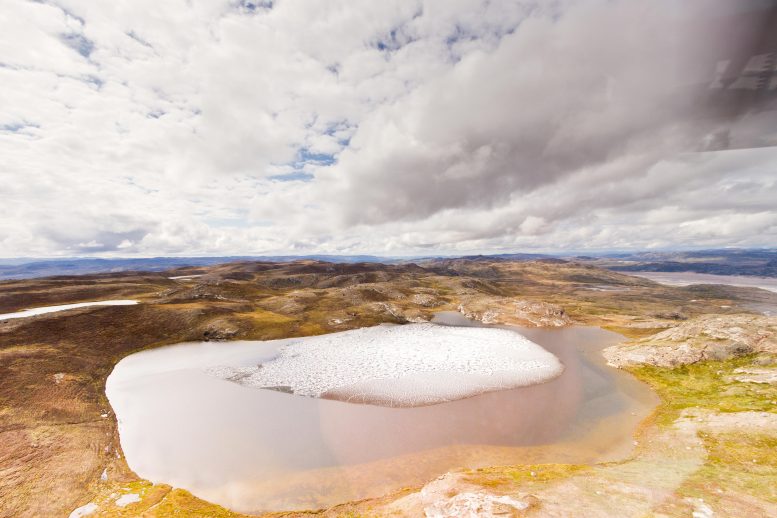
New analysis of sediments from the Camp Century ice core reveals that northwestern Greenland was ice-free during the Marine Isotope Stage (MIS) 11 interglacial period. This implies the Greenland Ice Sheet contributed to a significant rise in global sea levels during a time when global temperatures were similar to those projected for our near future.
Newly examined sediments retrieved from the base of the Camp Century ice core in northwestern Greenland suggest that the region was ice-free during a significant historical period – the Marine Isotope Stage (MIS) 11 interglacial period. This period is known to have some of the lowest global ice volumes recorded.
Implications for Sea Level Rise
The absence of ice in this region during the MIS 11 suggests that the Greenland Ice Sheet must have contributed over 1.4 meters of sea-level equivalent to the global sea level during this interglacial period. This period witnessed an average global air temperature similar to what we may soon experience due to human-induced climate warming.
Learning from Past Interglacial Periods
Past interglacials – periods during Earth’s climatic history characterized by warmer global temperatures and reduced global ice coverage – offer valuable insights into how Earth’s cryosphere may respond to our current warming climate and contribute to sea level rise. However, acquiring well-dated sedimentary records from areas that were ice-free during these interglacials is challenging due to current ice coverage.
Unveiling Hidden Information: The Case of the Camp Century Ice Core
An exceptional case is the Camp Century ice core from northwestern Greenland, which contained rare frozen subglacial sediments. These suggest that the region was ice-free at some point during the Pleistocene epoch. Andrew Christ and his colleagues analyzed the sediments using luminescence dating and cosmogenic nuclide data. They found that the sediments were deposited by flowing water in an ice-free tundra environment during the MIS 11 interglacial period (~416 thousand years ago), having been exposed at the surface and to sunlight less than 16,000 years prior.
Deeper Insight into Greenland’s Deglaciation during MIS 11
To further understand Greenland’s deglaciation during MIS 11, Christ and his team used an ensemble of ice sheet models. Their findings suggest that for the Camp Century location to be ice-free, melting of the ice sheet would have contributed to at least 1.4 meters of sea-level equivalent to the global mean sea level of the interglacial. This sea level was between 6 and 13 meters higher than at present.
Christ et al. conclude, “If moderate warmth for 29 [thousand years] during MIS 11 resulted in significant ice loss from Greenland, then rapid, prolonged, and considerable anthropogenic Arctic warming will likely cause melting of the [Greenland Ice Sheet], raise sea level, and trigger additional climate feedbacks in the coming centuries.”
For more on this research:
- Ice Core From Secret Cold War Army Mission Reveals Greenland Melted Recently
- Greenland’s Hidden History: Geoscientists Challenge Pre-Existing Climate Beliefs
Reference: “Deglaciation of northwestern Greenland during Marine Isotope Stage 11” by Andrew J. Christ, Tammy M. Rittenour, Paul R. Bierman, Benjamin A. Keisling, Paul C. Knutz, Tonny B. Thomsen, Nynke Keulen, Julie C. Fosdick, Sidney R. Hemming, Jean-Louis Tison, Pierre-Henri Blard, Jørgen P. Steffensen, Marc W. Caffee, Lee B. Corbett, Dorthe Dahl-Jensen, David P. Dethier, Alan J. Hidy, Nicolas Perdrial, Dorothy M. Peteet, Eric J. Steig and Elizabeth K. Thomas, 20 July 2023, Science.
DOI: 10.1126/science.ade4248
Never miss a breakthrough: Join the SciTechDaily newsletter.
1 Comment
This presents some obvious questions. If CO2 is driving the temperature changes that resulted in the NW GIS melting 416,000 years ago, why did the CO2 increase not just once, but several times, as shown here: https://en.wikipedia.org/wiki/File:Vostok_420ky_4curves_insolation.jpg
If it is Milankovitch Cycles that are driving the temperature changes, then doesn’t it stand to reason that the temperature changes are driving the CO2 and methane changes?